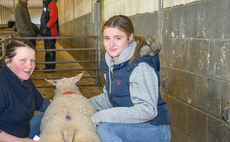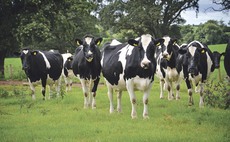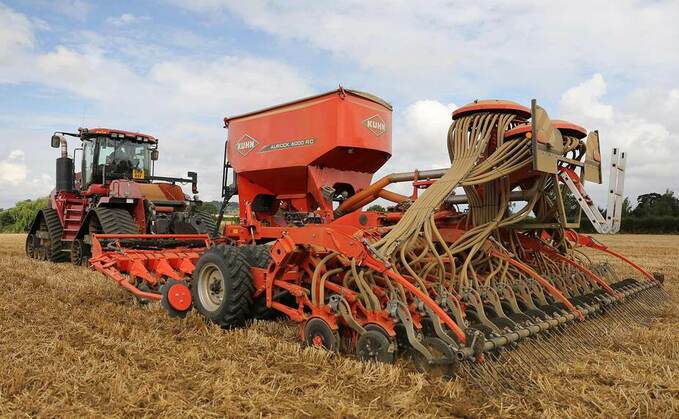
For one Warwickshire grower, flexibility is key when it comes to drilling, with a Kuhn Aurock 6000 RC joining the fleet. Alex Heath finds out how the direct drill has performed so far.
When it was launched at the French Sima Show in 2019, Kuhn's Aurock drill took a different tact to other direct drills already on the market. Principally designed to go straight into uncultivated ground with next to no surface disturbance, for Paul Wilson of G.W. Wilson, the drill is proving more versatile than billed, allowing cultivation and drilling strategies to be to tailored to soil types and conditions.
Farming 1,540 hectares around the business' base in Ilmington, Warwickshire, soils are on the whole hard to work, the predominant type being heavy Warwickshire clay, with plenty of Cotswold brash and marl for good measure, with a small proportion of lighter land on an outlying patch.
Mr Wilson says the farm took a good deal of time to decide on its next drill, with most direct drills considered and evaluated. The Aurock 6000 RC joins the farm's extensive fleet comprising an eight metre Vaderstad Rapid, 9m Horsch CO9 fitted with Dutch openers and a 4.5m Kuhn power harrow combi-drill.
"We have a very fluid drilling strategy, picking the best drill for the situation. It allows us to be adaptable with regards to soils, weather and crops, however, we need to capacity to cover the acres when the conditions allow.
"The idea behind buying a direct drill was to allow us the flexibility to reduce the cost and number of passes it takes to establish a crop, in addition to having more customers also wanting to go towards more regenerative methods. We looked at a number of makes, but the Kuhn stood out for its build strength and the amount of adjustment that can be made to it, allowing it to work directly into stubble, lightly cultivated and ploughed ground.
"Direct drilling is a new venture for us, so it has been a learning curve. We are learning every day we use it, which elements on the drill need more downforce, what the sowing depth should be and in the future, the drill will enable use to experiment with cover crops and companion crops," says Mr Wilson.
Tom Cox is in charge of using the Aurock, which is typically pulled with a Fendt 828 or Case IH Quadtrac 500.
Mr Cox says: "Generally, we will have the Fendt on the front, however, when harvesting that is tied up grain carting so we switch it onto the Quadtrac for early sown crops like oilseed rape. The Fendt is just up to pulling the drill, but will struggle on banks and in wet or hard conditions, while the Quadtrac walks away with it.
"The hopper is 5,000-litres which when full of seed and fertiliser is a fair weight behind the tractor. In addition, when wet, the wheeled tractor will slip and loosens the soil, which is when the full width wheels on the drill become clogged and stop turning. With tracks this does not happen. Swapping the drill between tractors is easy, being IsoBus controlled, it just plugs into the tractor's terminal."
The farm opted for the optional crop crimping roller at the front. Mr Wilson says: "We specced the crop roller as it is useful for seeding into cover crops and taller stubbles. It does not chop the crop up, it lays it over, protecting the soil."
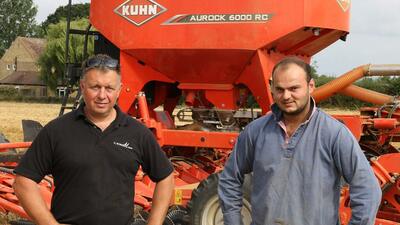
Drill elements
1
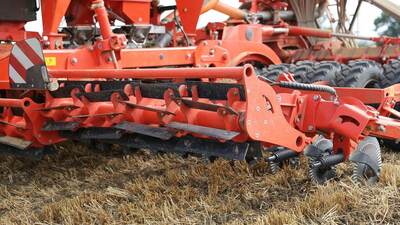
2
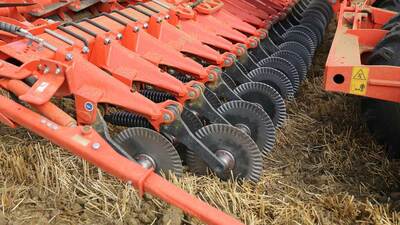
3
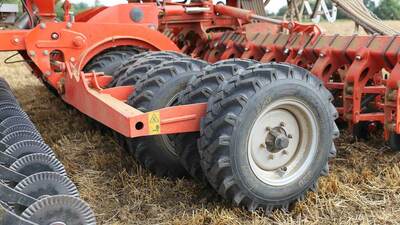
4
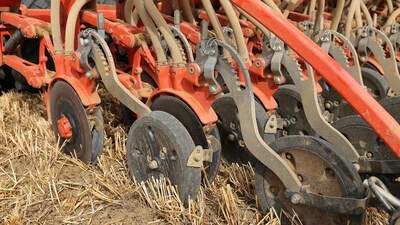
text
Behind is the drill's opening discs. Pressure of these is uniform across the full width, but a spring protection system is used should they encounter a stone. With embossed discs, Mr Wilson says they will cut into the hardest of soils and are typically run about 20mm below the seeding discs.
Following is a full width tyre press, which allows the drill to maintain consistent seeding depth, reduce compaction on the headlands and firm the seeding area. Staggered in pairs, the tyres are 275mm wide and have a diameter of 900mm, which in theory should allow them to keep turning in sticky conditions.
The wing sections of the tyre press fold up, should they become an issue, however, the ones underneath are fixed. Mr Wilson says it would be advantageous to be able to lift every other tyre or pair of tyres out of the way, especially when wet, ad is an option he would like to see in the future. He says: "Due to how open the drill is, the Aurock will keep going long after the Rapid is parked up, but like many of drills in this style the tyres are the limiting factor of how far you can go in challenging conditions."
At the rear, the coulter bar is pivoting, allowing coulters to follow the path cut by the opening discs. This also reduces the strain put on the discs when sowing around corners says Mr Wilson.
Putting the seed in the ground are double disc coulters, spaced 187.5mm apart. Individual downforce on each coulter allows fine tuning of depth, Mr Wilson says. This is particularly useful on the coulters that follow the tractor's wheelings, he adds. The fact that the coulters are at the back of the drill also makes adjustments easier and no longer require crawling under the hopper for the hard to reach ones.
Because the slot has already been cut, the pressure exerted on the coulters is relatively minimal compared to most drills, a benefit for running costs says Mr Wilson. The seed slot is firmed with a slanted press wheel and a following harrow also features.
Two seed types or seed and fertiliser can be put down each coulter and there is the opportunity to get every other coulter to sow a different seed. Products are metered through a pair of the manufacturer's volumetric metering systems and sent to separate distribution heads. "This is a massive plus for the Aurock," says Mr Wilson. "Often with bulk fertiliser, it can get ‘gummy' and then seed sticks to it and worst-case scenario the distribution head block up. With this drill that is not possible, so we know the seed rate is always right, regardless of the state of the fertiliser."
Calibration is also commended by Mr Cox. "It is simple to calibrate, putting the required seed rate into the computer. A button on the side of the hopper then allows the calibration to take place, which really speeds the job up."
From an operator's point of view Mr Cox says setting up and using the drill is simple. However, there are plenty of grease nipples to cover, with 128 on the coulters alone. The farm also moved the road lights forwards, closer into the drill, as they were too far back, and would have been prone to catching hedges when turning, Mr Wilson says, and a bout marker has been added to the left hand side for making working on the headlands more accurate.
Outputs of over 7ha/hr are achievable in moderate sized fields, with working speeds of 14kph typical, says Mr Cox.
Mr Wilson says most of the crops drilled with the Aurock will be done direct, with periodic subsoiling as required. "It is part of our strategy to reduce black grass, with minimal soil movement and hopefully reduce cabbage stem flea beetle damage of the rape, by keeping stubble heights relatively high to shield the growing crop. Above all the drill offers fluidity to our drilling strategy, couple to the chance to save time and money when establishing our crops," he concludes.

















